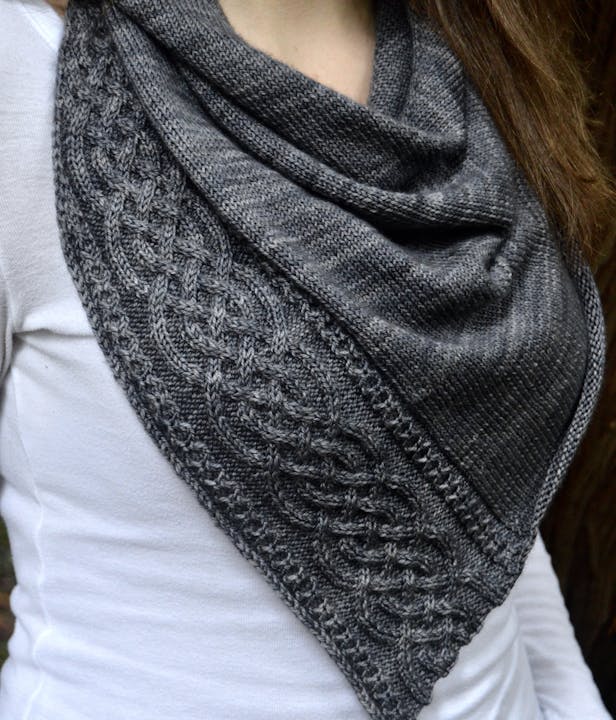How to cable without a cable needle!
Published on 25 January 2021 4 min read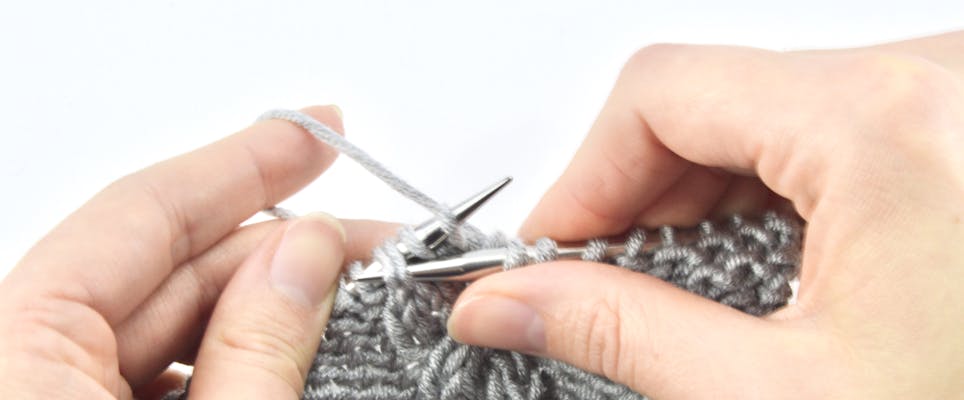
If you are like me, you love doing cable work but hate keeping track of that extra needle. Let me show you how I work cables without that fidgety needle.
I knit everywhere I go - have yarn, will travel! I have my trusty tool bag I keep in my purse; it's pretty small with only the necessities so I can just grab my current project and go. Any spare moment is a knitting moment!
One of my favorite things to knit is anything with cables. I don't know about you but when it comes to knitting cables that extra needle can be irritating. I'll set it down and forget where I left it or the cat or kid might knock it under the couch. Don't even ask how many are lost between the cushions! Let's say 'Goodbye' to that pesky needle, once and for all!
Please know this is just how I rearrange my stitches. There is no right or wrong way to do it, what's important is how the stitches end up on the needle.
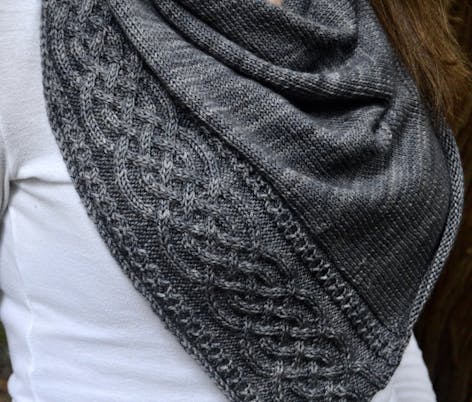

Take a deep breath, we are about to slide LIVE stitches off the needles! This is so we can change the order of those stitches. If these happen to twist on you that's totally fine. What's most important is getting them back on the needle; they can be fixed as you work your way through the pattern.
After you rearrange your stitches, your knitting will be a little tight and bunched up. This is normal and will even out as you work the stitches. Most important is to be sure you are working just one stitch at at time.
I highly recommend using pointy needles for cable work; they really help catch the stitches quickly and separately.
Let’s do a little break down on how cables are worked first.
Cable Basics
When you work your knitting, your stitches are worked in a straight line, in order (1, 2, 3, 4, etc.). To create a cable you are going to change the order the stitches are worked in. That's it!

Let's work a 2/2RC, which means 2 over 2 stitch right-leaning cable. This is worked over a total of four knit stitches. Instead of a 1, 2, 3, 4 order your stitches will be worked in this order: 3, 4, 1, 2.
To work this cable without a cable needle you will need to rearrange your stitches before you knit them. Once the stitches are in the order the cable directs, work the stitches across. It's that simple!
Ready to give it a go? Let’s start with a Right Cable.
Right Cable
Pro Tip
If you are cabling to the right, remember that the stitches that travel on the top of the work will cross to the right hand side or lean to the right. This cable can be written in a few ways, most commonly 2/2RC or C4R.
1
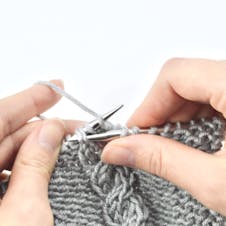
With your right-needle, slide the tip of the needle purlwise into the front of stitches 3 and 4. The stitches worked last in the cable will move across the back of the work (these are the stitches usually held in back on a cable needle).
2
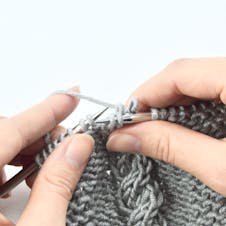
Carefully slide all four stitches off the left-hand needle; I like to hold or pinch the four stitches being rearranged just under the right-hand needle with my thumb and pointer finger to prevent them from dropping. Stitches 3 and 4 are still on the right-handed needle in the front of your work; stitches 1 and 2 are LIVE.
3
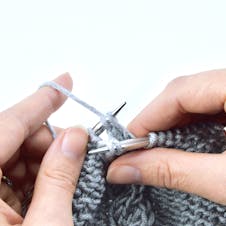
Take the tip of your left-needle, which is in back of your work, and slip stitches 1 and 2 back onto the left-needle. Do this as quickly as you can, so they don’t run away.
4
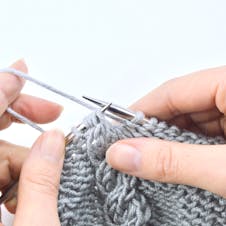
Bring stitches 3 and 4 across the front of the work and carefully slide them back onto the left-needle.
That’s it! Now just work across.
Left Cable
Pro Tip
Cabling to the left is just as simple, you only need remember that the stitches that travel in the front of the work will cross to the left hand side. This cable can be written in a few ways, most commonly 2/2LC or C4L.
1

With your right needle slide the tip of the right-needle purlwise into the back of stitches 3 and 4. The stitches worked last in the cable will move across the front of the work (these are the stitches usually held in front on a cable needle).
2
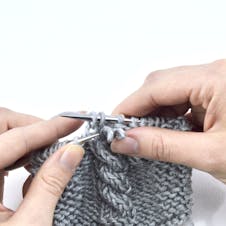
Carefully slide all four stitches off the left-hand needle, I like to hold or pinch the four stitches being rearranged just under the right-hand needle with my thumb and pointer finger to prevent them from dropping. Stitches 3 and 4 are still on the right-handed needle in the back of your work, stitches 1 and 2 are loose and LIVE.
3

Take the tip of your left needle, which is in front of your work, and slip stitches 1 and 2 back onto the left-needle. Do this as quickly as you can so they don’t run away.
4
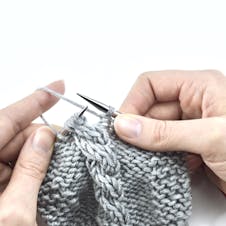
Bring stitches 3 and 4 across the back of the work and carefully slide them back onto the left-needle.
Ta-da, now just work across.
Any Cable?
These are examples of a 2-over-2 cable but this technique will work for all cables. Whether it is a combination of knit or purl stitches or an odd number of stitches, this method is an easy way to simplify cable knitting and one that is, in my opinion, worth learning.
Not all cables need to be worked this way. You can work a two stitch cable without rearranging them. This is a great way to quickly work those small cables. Ready?

Two Stitch Right Cable
Pro Tip
Let's do one-over-one to the right, which can also be written as 1/1RC or C2R.
1
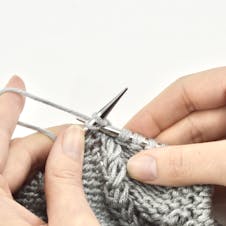
Knit into the second stitch from the front of the work, leave on the left-needle.
2

Knit into the first stitch, then slide the two stitches off the left-needle.
Two Stitch Left Cable
Pro Tip
Now, how about a one-over-one to the left? You might see this written as 1/1LC or C2L.
1
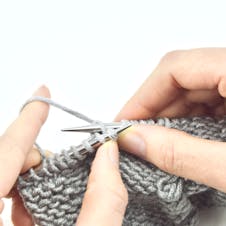
With your right-needle behind your work, knit the second stitch — take care not to twist your stitch — and pull the yarn through the stitch, leaving the stitch on the needle.
2
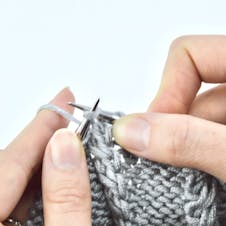
Knit into the first stitch, then slip the two stitches off the left-needle.
I have also made a video tutorial for you, so you can see it all in action.
That wasn't too scary, was it?! Now that you know my method of work cables, maybe it will become your favorite too. Do I always use this method? For the majority of my cables, YES! There are some that I find either too wide and awkward for this technique, and I will pull out that pesky cable needle for it. Or for the rare occasion there is that cable that requires two cable needles, for those I combine the two methods, hold some on a cable needle (or stitch holder) and rearrange the others…but that might be a post for another day!
Happy Knitting,
Makenzie

